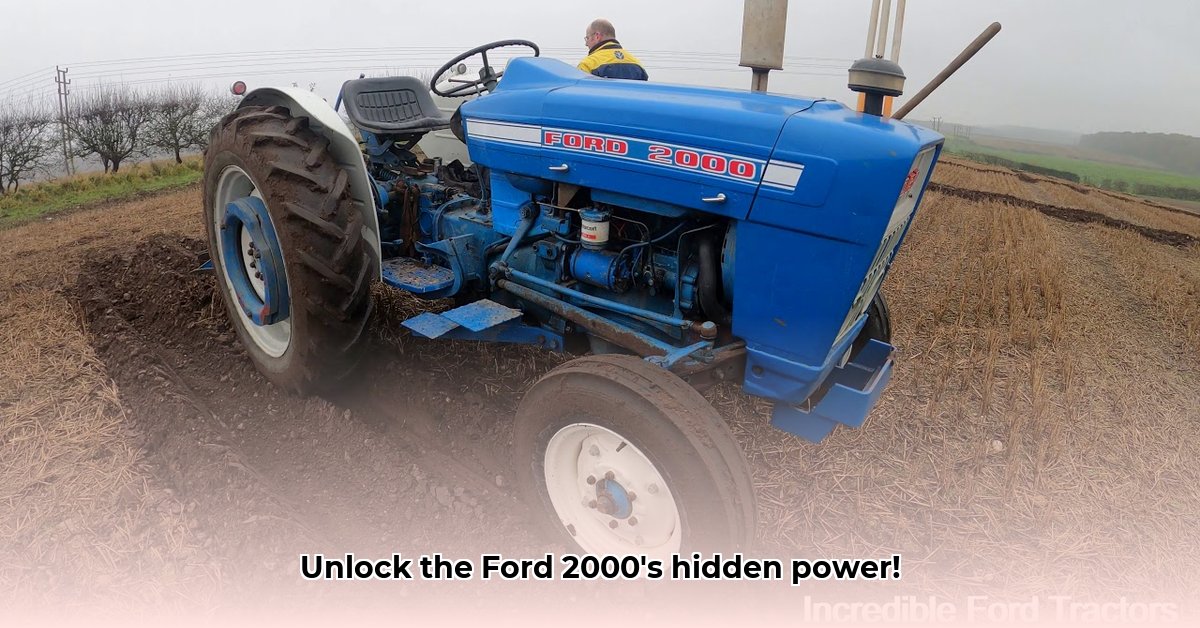
The Ford 2000, a three-cylinder icon of the agricultural world, toiled tirelessly in fields across the nation from approximately 1962 to 1975. While its production years are somewhat hazy, its impact on farmers and its enduring legacy are undeniable. This comprehensive guide delves into the history, mechanics, operation, and maintenance of this classic tractor, providing both historical context and practical, actionable advice for owners and enthusiasts alike. Did you know that its simple design and robust build are partly responsible for its lasting popularity? For even more information, check out this detailed guide: Ford 2000 info.
A Blast from the Past: The Ford 2000's History and Design
The Ford 2000 emerged during a pivotal era in agricultural technology. While not a technological marvel compared to modern tractors, it represented a significant advancement for many farmers, offering increased power and efficiency over older models. Its relatively affordable price point and straightforward design contributed to its widespread adoption. This tractor’s three-cylinder engine, available in both gasoline and diesel variants, was a key differentiator at the time, offering farmers options to match their needs and fuel availability. However, preliminary horsepower ratings often proved slightly higher than actual output—a common issue with early horsepower testing methodologies.
Unveiling the Mechanics: Technical Specifications and Features
At the heart of the Ford 2000 lies its compact 2.6-liter three-cylinder engine. The transmission, however, is a defining characteristic: it's unsynchronized, requiring a skilled touch to shift gears smoothly. This unsynchronized transmission, while initially challenging for novice operators, became second nature with practice. Depending on the model and year, the Ford 2000 offered between 4 and 12 gears, providing versatility for diverse tasks. This adaptability was further enhanced by optional features such as power steering and a front-end loader, adding to its overall utility. But let's be clear: this tractor prioritized function over comfort, with its open operator's station exposing the driver to the elements.
| Specification | Details |
|---|---|
| Engine | 2.6-liter, 3-cylinder (Gasoline or Diesel) |
| Transmission | Unsynchronized, 4-12 speeds |
| Power Take-Off (PTO) | Standard |
| Power Steering | Optional |
| Front-End Loader | Optional |
Bringing the Beast to Life: A Step-by-Step Operational Guide
Starting and operating a Ford 2000 demands a methodical approach. Before igniting the engine, always perform these crucial steps:
Fluid Check: Verify engine oil, coolant, and hydraulic fluid levels.
Fuel Check: Ensure an adequate fuel supply.
Safety Inspection: Examine brakes, lights, and the PTO for proper function. Address any potential issues before commencing operation.
Engine Start: Consult your owner’s manual for detailed starting instructions. Listen for any unusual sounds.
Gear Shifting: Practice smooth shifting to avoid gear grinding. Clutch manipulation is key to mastering the unsynchronized transmission.
Implement Attachment: Securely attach any implements, always following the manufacturer's guidelines. Don't forget safety chains!
Safe Operation: Maintain awareness of your surroundings and operate cautiously.
Maintaining Peak Performance: Essential Maintenance and Repairs
Regular maintenance is paramount to prolonging the life of your Ford 2000. Here's a basic maintenance schedule:
Oil Changes: Follow the owner's manual recommendations for oil change frequency.
Filter Replacements: Replace air, fuel, and oil filters regularly - clean filters equate to better engine performance.
Lubrication: Regular lubrication of moving parts helps prevent wear and ensures smooth operation.
Regular Inspections: Perform routine visual inspections to catch minor problems early on, preventing them from escalating into major issues.
Finding parts for an older tractor can be challenging, but online communities dedicated to vintage tractors offer valuable resources. Moreover, the rise of 3D printing offers potential solutions for hard-to-find or obsolete parts.
Restoring Your Ford 2000: A Rewarding Endeavor
Restoring a Ford 2000 to its former glory is a labor of love, requiring time, patience, and a dedicated approach. Online communities provide invaluable support, guidance, and often, access to essential parts.
The Ford 2000: A Legacy of Reliability and Charm
The Ford 2000, despite its limitations compared to modern tractors, remains a beloved machine. Its simple mechanics, relatively easy maintenance, and enduring durability have secured its place in agricultural history. While issues like the unsynchronized transmission and open operator station present challenges, the tractor's inherent simplicity and the strong community of enthusiasts ensure its continued relevance for many years to come. The Ford 2000: a robust, reliable workhorse that deserves its legacy.